信息化教学设计英语
- 格式:docx
- 大小:14.09 KB
- 文档页数:3
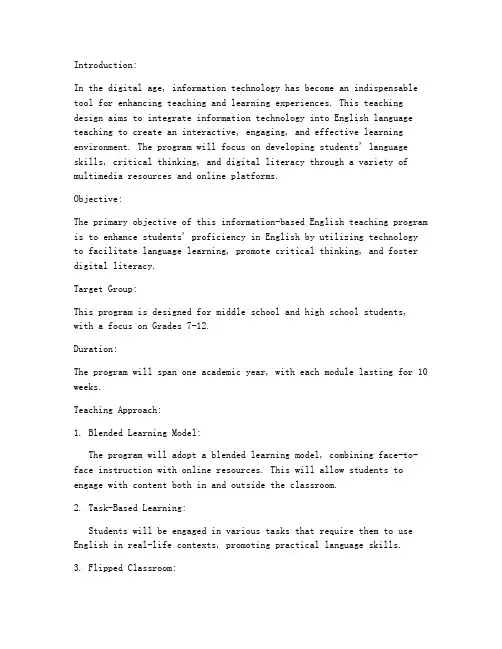
Introduction:In the digital age, information technology has become an indispensable tool for enhancing teaching and learning experiences. This teaching design aims to integrate information technology into English language teaching to create an interactive, engaging, and effective learning environment. The program will focus on developing students' language skills, critical thinking, and digital literacy through a variety of multimedia resources and online platforms.Objective:The primary objective of this information-based English teaching program is to enhance students' proficiency in English by utilizing technology to facilitate language learning, promote critical thinking, and foster digital literacy.Target Group:This program is designed for middle school and high school students, with a focus on Grades 7-12.Duration:The program will span one academic year, with each module lasting for 10 weeks.Teaching Approach:1. Blended Learning Model:The program will adopt a blended learning model, combining face-to-face instruction with online resources. This will allow students to engage with content both in and outside the classroom.2. Task-Based Learning:Students will be engaged in various tasks that require them to use English in real-life contexts, promoting practical language skills.3. Flipped Classroom:Students will be expected to watch video lectures or read online materials at home, allowing class time to be dedicated to discussion, practice, and application.Module Structure:The program will be divided into four main modules, each focusing on a different aspect of language learning:1. Basic Language Skills:- Grammar and vocabulary development through interactive online platforms and mobile applications.- Listening and speaking activities using audio and video resources.2. Reading and Writing:- Online reading materials, including e-books and digital newspapers, to develop comprehension skills.- Writing exercises using blogging platforms and collaborativewriting tools.3. Critical Thinking and Digital Literacy:- Analysis of online content to promote critical thinking skills.- Introduction to digital tools and resources for research andproject work.4. Project-Based Learning:- Group projects requiring students to research, plan, and present on a chosen topic using English.- Use of multimedia tools, such as video production and presentation software, to showcase their work.Teaching Materials and Resources:1. Online Platforms:- Interactive language learning websites like Duolingo, BBC Learning English, and Coursera.- Online libraries and databases for reading materials.2. Mobile Applications:- Language learning apps such as Rosetta Stone, Memrise, and HelloTalk for vocabulary and grammar practice.3. Digital Tools:- Google Classroom for managing assignments and communication.- Microsoft Office 365 for document creation and collaboration.4. Printed Materials:- Traditional textbooks and workbooks as supplementary resources.Assessment:1. Formative Assessment:- Regular quizzes and tests to monitor progress.- Online forums and discussions to assess engagement and participation.2. Summative Assessment:- End-of-module projects and presentations.- Final exams based on the curriculum objectives.Conclusion:This information-based English teaching program aims to leverage the power of technology to create a dynamic and effective learning environment. By integrating various digital tools and resources, the program seeks to enhance students' language skills, critical thinking abilities, and digital literacy, preparing them for the challenges of the 21st century.。
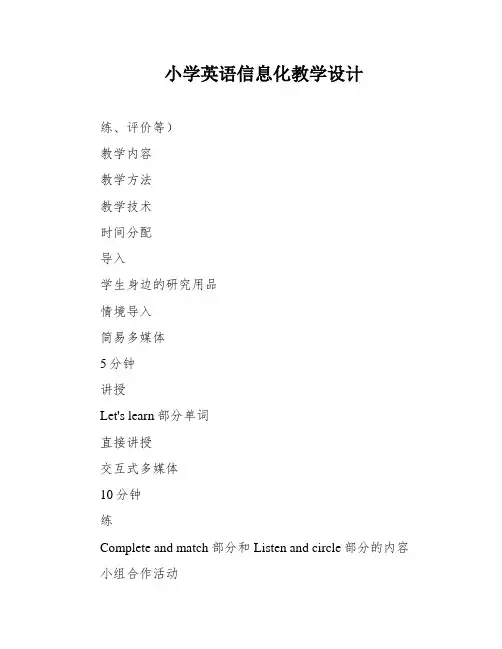
小学英语信息化教学设计
练、评价等)
教学内容
教学方法
教学技术
时间分配
导入
学生身边的研究用品
情境导入
简易多媒体
5分钟
讲授
Let's learn部分单词
直接讲授
交互式多媒体
10分钟
练
Complete and match部分和Listen and circle部分的内容小组合作活动
网络多媒体
15分钟
评价
学生自我介绍研究用品
小组展示
移动研究
10分钟
七、教学评价
1.教学效果评价:通过学生的听、说、读、写四个方面的
表现,来评价教学效果。
2.教学过程评价:通过观察学生在教学过程中的表现,来
评价教学过程。
3.教学方法评价:通过学生的研究反应和教师的教学感受,来评价教学方法。
4.教学环境评价:通过学生的研究反应和教师的教学感受,来评价教学环境。
5.教学资源评价:通过学生的研究反应和教师的教学感受,来评价教学资源。
源、工具)
本文介绍了一种多元化的教学方法,旨在通过训练、实验、研讨、探究、评价和建构等多种方式,提高学生的研究效果。
其中,引导学生通过观察图片并说出英文名称,既锻炼了他们的听、说、读、写能力,又激发了他们的研究兴趣。
在教学特色方面,本文强调了个性化教学和自主研究的重要性,同时也探讨了教与学方式的创新。
通过综合运用图片、视频、课件等信息技术工具,教师可以更好地支持学生的研究。
最终,这种多元化教学方法可以帮助学生更好地掌握知识,提高研究成绩。
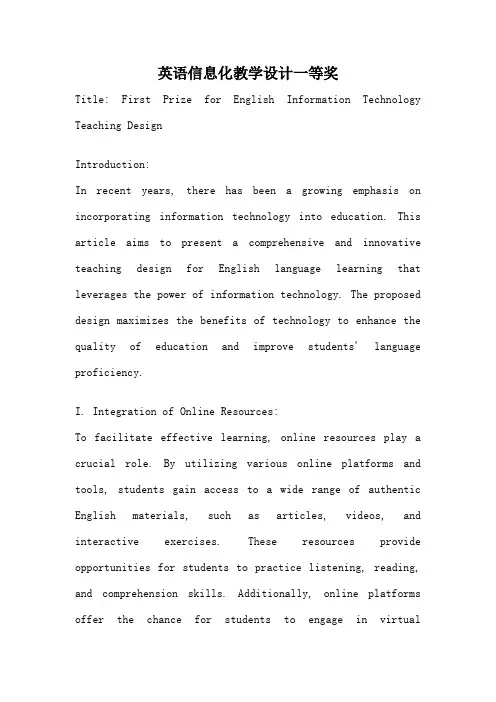
英语信息化教学设计一等奖Title: First Prize for English Information Technology Teaching DesignIntroduction:In recent years, there has been a growing emphasis on incorporating information technology into education. This article aims to present a comprehensive and innovative teaching design for English language learning that leverages the power of information technology. The proposed design maximizes the benefits of technology to enhance the quality of education and improve students' language proficiency.I. Integration of Online Resources:To facilitate effective learning, online resources play a crucial role. By utilizing various online platforms and tools, students gain access to a wide range of authentic English materials, such as articles, videos, and interactive exercises. These resources provide opportunities for students to practice listening, reading, and comprehension skills. Additionally, online platforms offer the chance for students to engage in virtualdiscussions and collaborative projects, fostering a sense of active learning and communication.II. Interactive Language Learning Applications:To enhance students' engagement and motivation, interactive language learning applications can be integrated into the teaching design. These applications offer personalized learning experiences, adaptive assessments, and instant feedback. Gamification elements, such as rewards and leaderboards, can be incorporated to create a competitive and enjoyable learning environment. These applications not only make language learning more enjoyable but also provide opportunities for students to practice speaking and writing skills in a simulated context.III. Virtual Reality (VR) Immersion:With the advancement of technology, virtual reality (VR) has emerged as a powerful tool for language learning. By immersing students in virtual environments, VR enables them to experience real-life situations and practice language skills in a realistic context. For instance, students can virtually travel to English-speaking countries, visit famous landmarks, and interact with virtual characters toimprove their language proficiency. VR technology offers a unique and immersive learning experience that enhances students' understanding and retention of English language concepts.IV. Blended Learning Approach:To cater to diverse learning styles and preferences, a blended learning approach can be adopted. This approach combines traditional classroom teaching with online learning activities. In the classroom, teachers can provide face-to-face instruction, conduct group discussions, and facilitate interactive activities. Online components can be used for self-paced learning, homework assignments, and individual practice. This blended learning approach promotes flexibility, autonomy, and self-directed learning, allowing students to progress at their own pace while receiving personalized guidance from teachers.V. Data Analytics for Individualized Feedback:Information technology also enables the collection and analysis of data to provide individualized feedback. By tracking students' learning progress and performance through online platforms, teachers can gather valuableinsights into each student's strengths and weaknesses. Based on this data, teachers can provide targeted feedback and tailor instructional strategies to meet individual learning needs. This data-driven approach helps optimize teaching effectiveness and ensures that students receive personalized support throughout their language learning journey.Conclusion:The integration of information technology into English language teaching brings numerous benefits to both teachers and students. Through the utilization of online resources, interactive language learning applications, virtual reality immersion, blended learning, and data analytics, students gain access to a more engaging, interactive, and personalized learning experience. By embracing these innovative teaching approaches, English language education can be transformed, leading to improved language proficiency and ultimately, the achievement of the first prize in teaching design.。
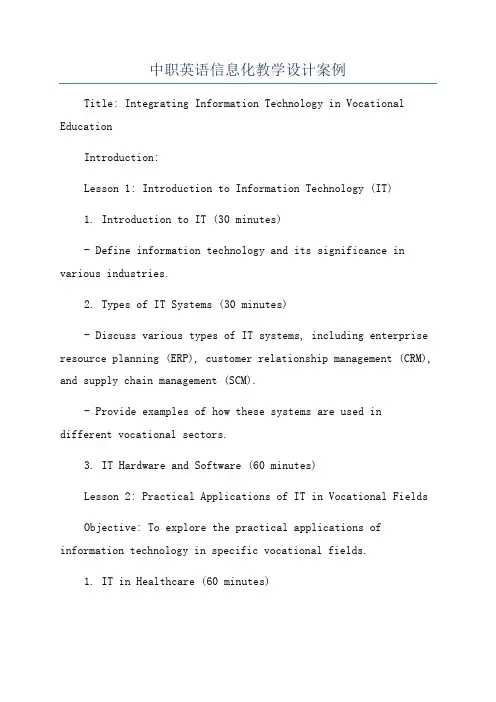
中职英语信息化教学设计案例Title: Integrating Information Technology in Vocational EducationIntroduction:Lesson 1: Introduction to Information Technology (IT)1. Introduction to IT (30 minutes)- Define information technology and its significance in various industries.2. Types of IT Systems (30 minutes)- Discuss various types of IT systems, including enterprise resource planning (ERP), customer relationship management (CRM), and supply chain management (SCM).- Provide examples of how these systems are used indifferent vocational sectors.3. IT Hardware and Software (60 minutes)Lesson 2: Practical Applications of IT in Vocational Fields Objective: To explore the practical applications of information technology in specific vocational fields.1. IT in Healthcare (60 minutes)- Discuss the use of electronic health records, telemedicine, and medical imaging systems.- Organize a virtual tour or guest lecture by professionals working in healthcare IT.2. IT in Manufacturing and Engineering (60 minutes)3. IT in Business and Marketing (60 minutes)Lesson 3: Ethical and Security Considerations in ITObjective: To address ethical and security issues related to information technology.1. Ethical Use of IT (30 minutes)- Discuss the importance of ethical behavior when using IT systems, including privacy, copyright laws, and responsible data usage.- Engage students in a class discussion about real-life ethical dilemmas related to information technology.2. IT Security (60 minutes)- Teach students how to protect themselves and their devices from cyber-attacks.3. IT and Cybersecurity Careers (30 minutes)- Introduce different career opportunities in the field of cybersecurity.- Invite a guest speaker who works in cybersecurity to share their experiences and provide career guidance.Conclusion:。
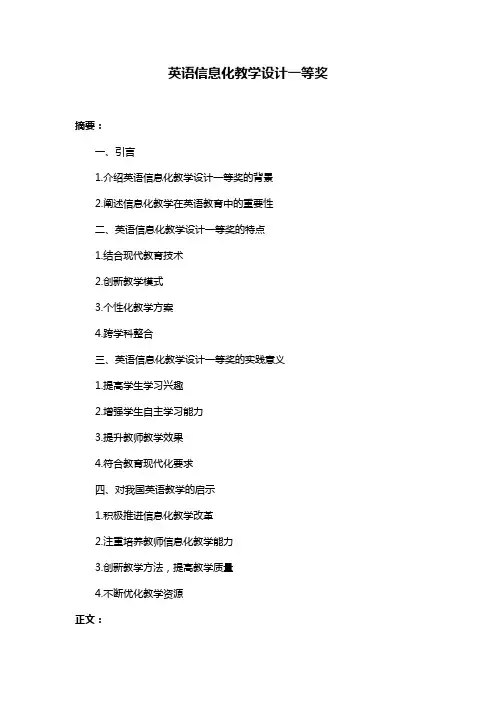
英语信息化教学设计一等奖摘要:一、引言1.介绍英语信息化教学设计一等奖的背景2.阐述信息化教学在英语教育中的重要性二、英语信息化教学设计一等奖的特点1.结合现代教育技术2.创新教学模式3.个性化教学方案4.跨学科整合三、英语信息化教学设计一等奖的实践意义1.提高学生学习兴趣2.增强学生自主学习能力3.提升教师教学效果4.符合教育现代化要求四、对我国英语教学的启示1.积极推进信息化教学改革2.注重培养教师信息化教学能力3.创新教学方法,提高教学质量4.不断优化教学资源正文:英语信息化教学设计一等奖的背景是近年来我国英语教育领域对于信息化教学的重视与推广。
英语作为国际化的语言,在我国的基础教育和高等教育阶段占有重要地位。
信息化教学作为一种新型的教学方式,对于提高英语教学质量具有重要意义。
英语信息化教学设计一等奖的特点主要体现在结合现代教育技术、创新教学模式、个性化教学方案以及跨学科整合。
首先,它充分利用网络、多媒体等现代教育技术手段,为学生提供丰富的学习资源;其次,创新教学模式,如在线学习、翻转课堂等,使学生能够更加主动地参与学习过程;此外,根据学生的特点和需求制定个性化教学方案,提高学习效果;最后,跨学科整合,将英语与其他学科知识相结合,拓展学生的知识视野。
英语信息化教学设计一等奖的实践意义主要表现在提高学生学习兴趣、增强学生自主学习能力、提升教师教学效果以及符合教育现代化要求。
通过信息化手段,使英语学习变得更加生动有趣,激发学生的学习兴趣;同时,培养学生自主学习能力,使他们能够更好地适应未来社会的发展;此外,信息化教学有助于提高教师的教学效果,提升教育教学质量;最后,信息化教学符合教育现代化的要求,有助于推动我国教育事业的改革与发展。
对我国英语教学的启示主要包括积极推进信息化教学改革、注重培养教师信息化教学能力、创新教学方法,提高教学质量以及不断优化教学资源。
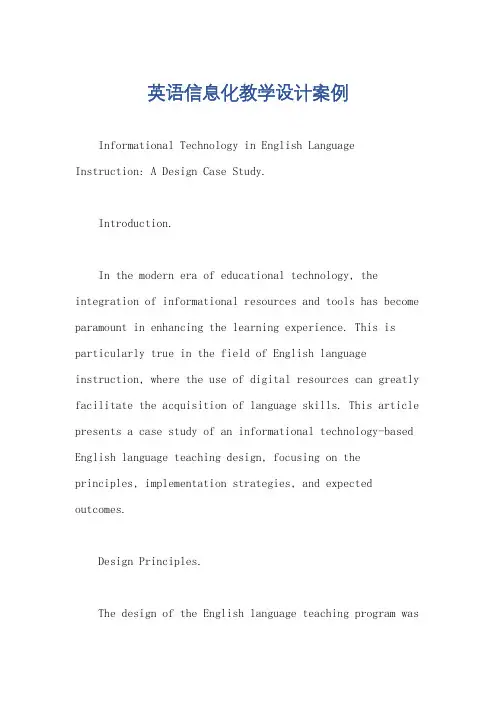
英语信息化教学设计案例Informational Technology in English Language Instruction: A Design Case Study.Introduction.In the modern era of educational technology, the integration of informational resources and tools has become paramount in enhancing the learning experience. This is particularly true in the field of English language instruction, where the use of digital resources can greatly facilitate the acquisition of language skills. This article presents a case study of an informational technology-based English language teaching design, focusing on the principles, implementation strategies, and expected outcomes.Design Principles.The design of the English language teaching program wasguided by several key principles:1. Student-Centered Learning: The program places the student at the center of the learning process, encouraging active participation and collaboration. Digital resources are used to create an interactive and engaging learning environment that caters to the diverse needs and interests of students.2. Blended Learning: The program combines traditional classroom instruction with online learning activities, leveraging the strengths of both approaches. This allows for a flexible and personalized learning experience that accommodates different learning styles and schedules.3. Authentic Language Use: The program emphasizes the use of authentic language materials and real-world scenarios to promote meaningful language use. This helps students develop the ability to communicate effectively in real-life contexts.4. Technology Integration: The program integrates arange of educational technologies, including interactive whiteboards, online learning platforms, and multimedia resources. These tools are used to enhance teaching and learning, making the content more accessible and engaging.Implementation Strategies.The following strategies were employed in the implementation of the English language teaching program:1. Curriculum Development: A comprehensive curriculum was developed that aligns with national education standards and incorporates informational technology resources. The curriculum covers a range of language skills, including reading, writing, speaking, and listening.2. Teacher Training: Teachers were provided with professional development opportunities to equip them with the necessary skills and knowledge to effectively integrate informational technology into their teaching practices. This included workshops on digital tools and resources, as well as strategies for promoting student engagement andcollaboration.3. Classroom Practices: In the classroom, teachers utilized digital resources to create interactive and engaging learning experiences. They employed a variety of teaching methods, such as collaborative projects, role-playing activities, and online discussions, to promoteactive learning and language use.4. Online Learning Platform: An online learningplatform was introduced to support blended learning. This platform provided students with access to digital materials, online assignments, and interactive exercises. It also allowed for teacher-student and student-student communication, facilitating collaboration and feedback.Expected Outcomes.The expected outcomes of the English language teaching program include:1. Improved Language Skills: Students will demonstrateimproved reading, writing, speaking, and listening skills through regular practice and exposure to authentic language materials.2. Enhanced Engagement and Motivation: The use of digital resources and interactive learning activities will foster a more engaging and motivating learning environment, increasing student participation and engagement.3. Development of Collaborative Skills: Collaborative projects and online discussions will promote teamwork and communication skills, preparing students for future academic and professional challenges.4. Preparedness for the Digital Age: By integrating informational technology into their learning experiences, students will be better prepared to navigate the digital age and utilize technology effectively in their academic and career pursuits.In conclusion, the integration of informational technology in English language instruction offerssignificant benefits to both teachers and students. By embracing a student-centered, blended learning approachthat leverages the power of digital resources and tools, we can create a more engaging, effective, and future-ready learning environment.。

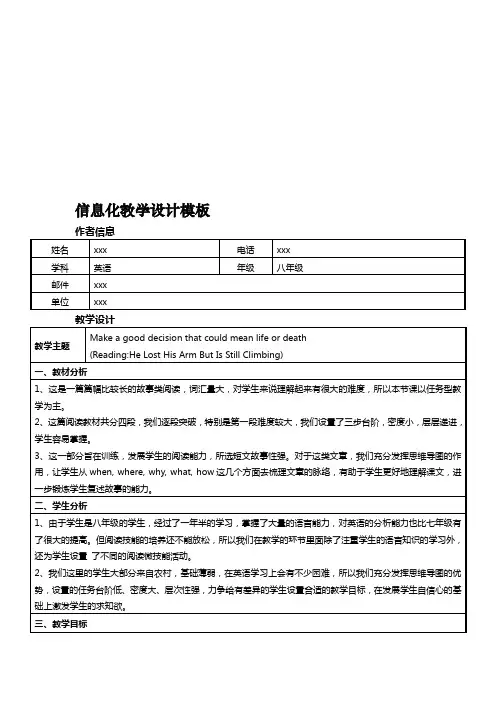
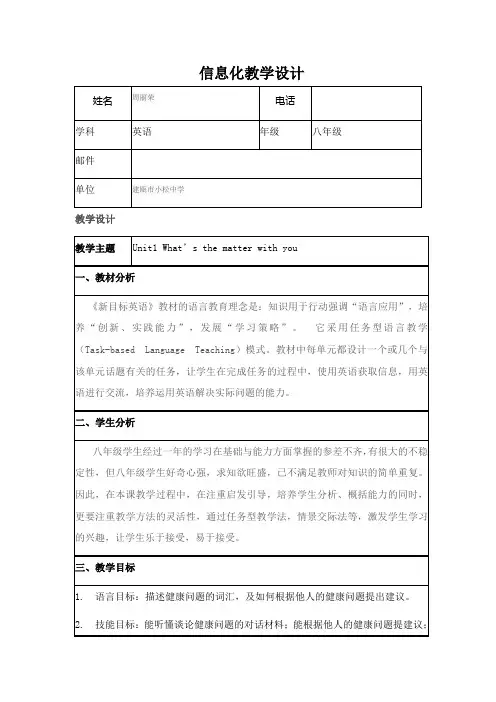
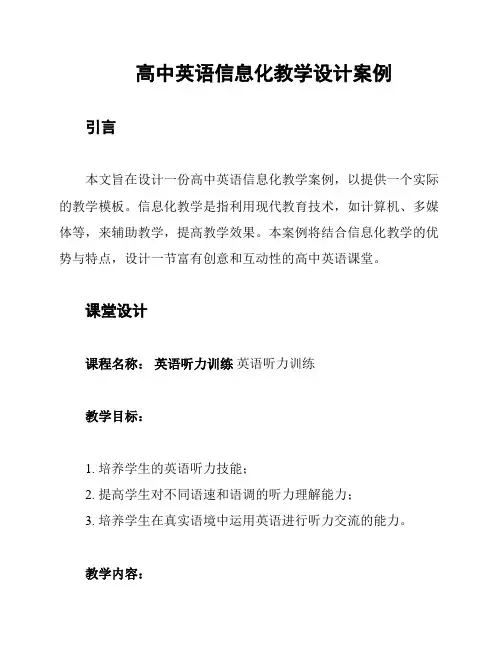
高中英语信息化教学设计案例引言本文旨在设计一份高中英语信息化教学案例,以提供一个实际的教学模板。
信息化教学是指利用现代教育技术,如计算机、多媒体等,来辅助教学,提高教学效果。
本案例将结合信息化教学的优势与特点,设计一节富有创意和互动性的高中英语课堂。
课堂设计课程名称:英语听力训练英语听力训练教学目标:1. 培养学生的英语听力技能;2. 提高学生对不同语速和语调的听力理解能力;3. 培养学生在真实语境中运用英语进行听力交流的能力。
教学内容:1. 听力原文:一段关于如何健康饮食的英语短文;2. 听力练:针对短文内容安排多个听力练题,包括听取关键信息、理解说话者意图等。
教学步骤:1. 引入:通过展示一张健康饮食的图片,引起学生对话题的兴趣;2. 信息化演示:播放视频,展示一段关于健康饮食的视频,引导学生对话题的讨论;3. 听力原文讲解:给出关于健康饮食的英语短文原文,通过教师的讲解和问答互动,帮助学生理解原文内容;4. 听力练:安排多个听力练题,如填空、选择题等,帮助学生巩固听力技能;5. 听力讨论:引导学生就听力练题进行讨论,提高他们理解说话者意图的能力;6. 反馈与总结:教师给予学生听力练的反馈与评价,并总结本节课的研究成果。
信息化教学活动策略1. 利用多媒体资源:通过播放视频、展示图片等多媒体资源,丰富教学内容,激发学生兴趣;2. 提供个性化研究:根据学生的不同水平和需求,提供个性化的听力练题,帮助他们更好地掌握听力技巧;3. 引导学生互动与讨论:通过教师的引导和组织,鼓励学生与同学一起进行听力讨论,提高他们的交流能力和合作意识;4. 及时反馈与评价:教师在课堂上对学生的听力练进行及时反馈和评价,帮助他们发现问题并改进。
总结本教学设计案例充分利用信息化技术的优势,通过多媒体资源和个性化研究策略,提高了教学的创意和互动性。
通过这样的信息化教学方式,学生能够更好地培养英语听力技能,并在真实语境中灵活运用所学知识。

Will people have robots?第一课时信息化教学设计陕西师范大学外国语学院教育硕士张红星 J10136目录一、教材分析及学情分析二、教学目标三、教学重点四、教学难点五、教学思路设计六、教法与学法设计七、教学软件及媒体设计八、教学过程设计九、教学评价设计十、教学反思十一、教学流程图一、教材分析及学情分析:在英语教学中,一个单元是一个不可分割的整体,因而我们在分析处理教材时要从整体上把握。
依据任务型教学理念,我们可试先找出本单元中每个课时的中心话题或任务是什么,然后围绕这个中心话题或任务展开任务型教学。
本单元重点学习一般将来时态“will+ V”.在课本中涉及了there will be 的一般将来时态的肯定形式和否定形式。
培养学生敢于预测未来、陈述表达各自不同的观点:例如对未来的生活、职业、环境等做出设想,表达了学生对美好生活的憧憬与向往。
比较新颖的话题有月球上的生活、“钱”在未来能否继续使用、学生不用去学校上学,谈论人的寿命等都将在本单元中出现。
这也体现了“新教材”的创新之处。
在对more,less,fewer的对比之中,提高了学生的辨别力。
增强了学生对植树、减少车尾气、保护环境的意识,使语言学习贴近生活、融于生活、服务生活、超越生活,也使语言在生活中得到了更好的应用。
本节课是《人教版八年级英语下册》第一单元第一课时,本节课围绕一般将来时态展开讨论。
运用教学软件,实施任务型教学,提高了学生学习英语的趣味性,有助于培养其用英语思维的学习习惯。
八年级的学生已经具备一定的基本知识和技能,对基本的课堂用语,教师的指令已经基本掌握。
本课时是人教版八年级上册第一单元的第一课时。
在这个单元中主要是围绕我们的生活将会发生什么样的变化的问题,让学生运用一般将来时对未来的事情进行猜测。
第一课时主要是对学生进行听说的训练。
抓住这一点,设计一系列的任务活动容易激发学生的学习兴趣,让学生在学习英语的同时,用英语解决生活中的问题。
信息化教学设计方案—英语Name: UnknownSubject: EnglishEmail: Unknownn: UnknownPhone: UnknownGrade: High School Grade OneXXX:XXX:1.Textbook AnalysisThis module focuses on the topic of Films and TV Programmes。
The aim is to enable students to use the XXX and TV shows。
introduce their favorite directors。
correctly understand articles that introduce movies。
XXX。
During the reading process。
students will learn to grasp the main idea of each paragraph。
write movie and TV reviews from the aspects of background。
plot。
characters。
and actors。
and accurately use frequency adverbs in the text。
This module will help students to view movies and TV shows correctly。
increase their knowledge ofscience and culture through the n of good movies and TV shows。
XXX.2.Student AnalysisXXX of most students in the class。
they often cannot XXX has caused students to lose interest and n in learning English。
小学英语信息化教学设计信息化教学是指通过信息技术手段,将传统教学与现代技术相结合,使教学更加高效、生动、有趣。
在当今信息社会的背景下,信息化教学已经成为教育领域的重要发展方向之一。
对于小学英语教学而言,也可以充分利用信息化教学手段,提高教学效果和学习兴趣。
本文将探讨小学英语信息化教学的设计及其实施策略。
一、利用多媒体教学资源信息化教学的一大特点就是使用多媒体教学资源,包括音频、视频、动画等。
在小学英语教学中,教师可以利用这些资源设计一些生动有趣的教学活动,并且引导学生积极参与其中。
例如,教师可以播放英语歌曲、动画片等,让学生通过听歌、唱歌、跟读等方式来学习英语。
同时,教师还可以选择一些英语相关的绘本,通过展示图片、讲故事等方式让学生更好地理解和掌握英语知识。
二、开展虚拟实验教学信息化教学还可以借助虚拟实验平台,让学生通过模拟实验的方式来学习英语知识。
例如,在学习英语单词拼写方面,教师可以设计一个虚拟实验平台,让学生通过输入拼写,并且通过视觉效果进行即时反馈。
这样,学生能够不断练习并且从错误中学习,提升英语单词拼写能力。
三、利用社交媒体进行课外拓展学习在小学英语信息化教学中,教师可以引导学生利用社交媒体进行课外拓展学习。
例如,学生可以加入英语学习群组或关注一些英语学习的公众号,在社交媒体上与其他学生交流以及参与各种英语学习活动。
这样做不仅可以扩大学生的英语学习范围,还能够增强学生的学习动力和交流能力。
四、开展网络辅助教学和作业信息化教学还可以借助网络辅助教学平台和作业系统,提供更加个性化和有效的教学服务。
在小学英语教学中,教师可以利用网络辅助教学平台,为学生提供一些在线学习资源和教学材料。
同时,教师还可以利用作业系统,布置一些在线作业并及时批改。
这样,学生可以在家进行灵活学习,教师也可以更好地跟踪学生的学习情况。
五、评估学生学习效果信息化教学还可以通过一些在线评估系统,对学生的学习效果进行评估。
通过这些系统,教师可以快速了解学生掌握的程度,并及时调整教学策略和教学内容。
信息化教学设计方案初中英语一、教学目标1.知识与能力目标:a)学会掌握基础的英语单词、词组和句子,能够读懂初中英语课文。
b)学会应用所学知识进行简单的口语表达和书面写作。
c)培养学生的听说读写能力,提高英语综合运用能力。
2.过程和方法目标:a)通过信息化教学手段,让学生对英语学习产生浓厚的兴趣。
b)利用多媒体技术,提供丰富的听力材料,培养学生的听力理解能力。
c)引导学生合作学习,通过小组讨论和互动,提高学生的口语表达能力。
d)利用互联网资源,让学生进行网络和信息收集,培养学生的自学能力。
二、教学过程1.课堂导入a)展示一段有趣的英语视频或音频,引起学生的兴趣。
b)激发学生的学习动机,让学生思考学习英语的重要性。
2.基础知识教学a)使用多媒体教学手段,呈现英语单词、词组和句子的学习内容。
b)利用图片、声音和视频等多种形式,帮助学生理解和记忆关键词汇和句子。
3.听力训练a)播放多段英语对话或短文,要求学生听懂并完成相关的听力题目。
b)通过听力训练,培养学生对英语语音和语调的感知能力,提高听力理解能力。
4.互动交流a)分组进行小组讨论和互动,让学生用英语进行口语表达。
b)提供主题和问题,引导学生积极参与讨论,增强语言表达能力。
5.书面表达a)要求学生根据所学知识进行写作练习,例如写一篇日记、描述一件事情等。
b)鼓励学生使用多种资源和工具进行写作,例如使用英语写作软件或互联网资源。
6.信息a)引导学生利用互联网和收集与所学英语知识相关的信息。
b)教授学生如何评估信息的可信度和使用合适的信息技巧。
7.总结归纳a)让学生回顾本节课所学的知识点,提出问题并进行讨论。
b)对学生的学习情况进行评价,鼓励学生发表意见和建议。
三、教学评价1.老师可以通过观察学生在课堂上的互动和表现来评价学生的听说读写能力。
2.老师可以设计一些小测验或考试来评价学生对所学知识的掌握程度。
3.老师可以使用互联网和多媒体技术,收集学生的作业和表现,并进行评价和反馈。
英语信息化教学设计一、引言陶行知先生有次在武汉大学讲演,竟从皮包里拿出一只大公鸡,在众人诧异的目光中,他按住公鸡的头,强逼它吃他放在桌上的一把米,可公鸡只叫不吃。
然后他松开手,自己后退了几步,这时候公鸡自己吃起米来。
接着陶先生开始讲演:“我认为,教育就跟喂鸡一样!先生强迫学生去学习,把知识硬灌给他,他是不情愿学的,即使学,也是食而不化,过不了多久,他还会把知识还给先生的。
但是,如果让他自由地学习,充发挥他的主观能动性,那效果一定会好得多!”二、背景信息技术是指人类对数据、语言、文字、声音、图画和影像等各种信息进行采集、处理、存储、传输和检索的经验、知识及其手段、工具的总和。
它的核心技术是3C(computer,communication,contents)。
信息技术与课程教育教学的整合是教育部面向新世纪所制定的英语新课程标准大力提倡的:“在开发英语课程资源时,要充分利用信息技术和互联网”。
“整合”是为了更好地实现信息技术教育和英语教学的目标———培养学生获取、加工和利用信息的能力,以人为本,培养学生的综合语言运用能力。
以计算机技术和网络通讯技术为主要标志的信息技术,对当今社会产生重大影响,使教育思想、观念、模式等发生了巨大变化。
信息技术与学科教学的整合(IntegratingInformationTechnologyintotheCurriculum-IITC),已成为基础教育教学改革的新视点。
如何在高中英语教学中利用电脑和网络技术,改善高中英语教学模式,有效地实现信息技术与英语学科的整合成为广大教育工作者与一线教师共同关注与研究的热点问题。
四、整合教学案例介绍与分析本节课主要目标通过WarmingupandSpeaking(热身及口语)的学习达到以下目标:1.\n用新旧知识解决问题,完成任务。
在此基础上鼓励学生大胆地根据各自的语言基础与能力,有个性地解决问题,就如何有效地节约水、保护水提出独特的见解。
英文信息化处理教学设计模板范文English:In designing a teaching template for information technology processing, it is essential to incorporate a blend of theoretical knowledge and practical application. The curriculum should start with an introduction to fundamental concepts such as data types, data structures, algorithms, and programming languages. This foundational knowledge will provide students with a solid understanding of the principles behind information processing. The teaching approach should then transition into hands-on practice, allowing students to apply their theoretical knowledge to real-world scenarios. Through practical exercises and projects, students can develop problem-solving skills and gain valuable experience in utilizing various software tools for information processing. Additionally, the curriculum should include case studies and examples from industry best practices to help students understand the relevance and importance of information technology processing in different sectors. By providing a comprehensive and well-rounded educational experience that combines theory, practice, and real-world applications, students will be better equipped to succeed inthe field of information technology processing.Chinese:在设计信息化处理教学模板时,必须结合理论知识和实际应用。
信息化教学设计模板
作者信息
姓名秦艳电话
学科英语年级七年级
邮件
单位济宁高新区王因中心中学
教学设计
教学主
What does he look like
题
一、教材分析
本节课是七年级下册第九单元“What does he look like”的内容。
本单元的核心项目是“描述人的外貌”(Describe People),涉及到讨论人的身高、体重、发型、面部特征及其着装等语言项目。
教材内容围绕着描述人的外貌特点展开,让学生学会谈论人的身高、体重、发型、面部特征及着装特点,以人的外貌特征为主线,兼顾交际功能的学习,以一种循序渐进的生活化的学习程序,引导学生学会用英语介绍自己或他人的外貌特征。
这些内容与学生的实际生活密切相关,易于引发学生运用简单的英语进行交际和交流,在学习活动中,学生能通过交换对不同人物的描述及看法,促进学生之间和师生之间的情感交流,增进情谊
二、学生分析
本节课的对象是七年级的学生,这阶段的学生比八、九年级学生更活泼、天真,对新事物有很高的激情,针对这样的学生,要全面激发他们的学习兴趣,很适合采用多媒体等信息化手段充分调动他们的学习积极性,得到一个很好的教学效果。
另外,学生在七年级上册已经学过关于“What does he like”这一特殊疑问句式,具有了学习本单元知识的认知前提,能自然地与本单元话题进行衔接。
谈论人的外表形象是人们日常生活中遇到的话题。
故学生乐于用英语表达此类知识。
三、教学目标
1.?语言知识目标:
(1)?能掌握以下单词:?curly, straight, tall, medium, thin, heavy, build, tonight, little, cinema, glasses, later?
(2)能掌握以下句型:
—What does he look like?? —He’s of medium/build.
—What does he look like?? —She has long straight hair.
—Is he tall or short?—He’s tall.
2.?情感态度价值观目标:
让学生学会友好、客观地描述人的形象。
四、教学环境
√简易多媒体教学环境□交互式多媒体教学环境□网络多媒体环境教学环境□移动学习□其他
五、信息技术应用思路(突出三个方面:使用哪些技术?在哪些教学环节如何使用这些技术?使用这些技术的预期效果是?)200字
在教学中,我运用多媒体白板进行教学,这需要制作大量的PPT,需要进行选取大量的与教材有关的图片以及音频视频,课件是本课的一大辅助,在语言输入环节,借助丰富的人物图片来引导学生说出单词,并进行造句巩固。
既可以降低难度,又调动了学生的兴趣,学生学得快记得牢。
我还从网上截取了一小段动画Flash做成了微视频,让学生观看微视频,体验句型?What does he look like??的使用环境。
与PPT结合使用,利用电子白板的交互作用,较好地发挥师生互动的功能。
六、教学流程设计(可加行)
教学环节
(如:导入、讲
授、复习、训练、实验、研讨、探究、评价、建构)教师活动学生活动
信息技
术支持
(资
源、方
法、手
段等)
Warming up Play a game “Polly says…”.Tell the Ss the
rules:If Polly says touch your
eyes/ears/nose/mouth/shoulder/legs/arms.
You should do it. If it doesn’t say that,
you can’t do it. If you are wrong, you have
to sit down. The person who does it
correctly is the winner.
Do it happily
师生双
边活动
Lead-in播放多媒体视频《大头儿子小头爸爸》学生说说视频Flash
中几个人物的
特征。
课件
Presentation 播放微课——课前让几个特征明显的同学提前
做一个对话。
涵盖这节课的重点单词及句型。
教师对小组进行评价。
1.学生根据
微课Pair?
work.
2.学生自己
编写对话。
进行Group
work.
微课
Practice教师播放1b,2a,2b对话Listen and
answer the questions.
播放电
脑上听
力内容
Homework 1. Remember all of the new words. 2. Do the
Ex. in the Ex. Book. 3.Describe your family
members and draw a picture of them.
Do the
homework
PPT
七、教学特色(如为个性化教学所做的调整,为自主学习所做的支持、对学生能力的培养的设计,教与学方式的创新等)200字左右
本课利用多媒体信息化进行教学,充分发挥了多媒体声音、图像、文字、动画为一体的优?势,呈现直观,让视听有机结合,能使学生自然地将英语学习直接与现实生活中的事物建立联系,有助于培养学生用英语思维的能力。
此外,在教授语法的过程中将?传统的填鸭式教法转变成教师引导、学生看图自主归纳,这样更能凸现学生的主体地位。
整节课我不仅激发学生的学习兴趣,活跃了课堂气氛,而且循序渐进地落实了各教学步骤,取得了较好的教学效果。